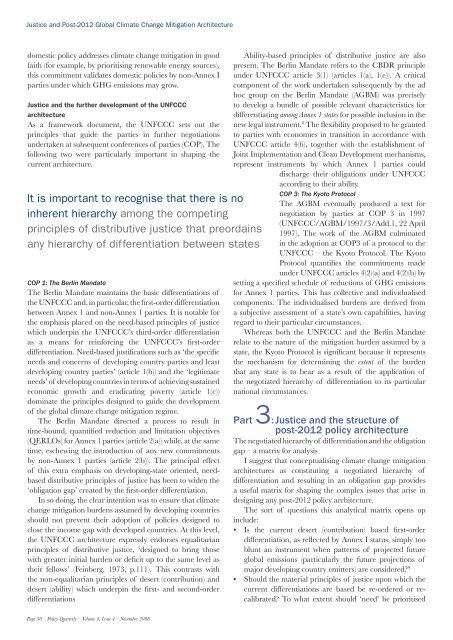Sharing the Burden of Climate Change Policy Quarterly issue with ...
Sharing the Burden of Climate Change Policy Quarterly issue with ...
Sharing the Burden of Climate Change Policy Quarterly issue with ...
Create successful ePaper yourself
Turn your PDF publications into a flip-book with our unique Google optimized e-Paper software.
Justice and Post-2012 Global <strong>Climate</strong> <strong>Change</strong> Mitigation Architecture<br />
domestic policy addresses climate change mitigation in good<br />
faith (for example, by prioritising renewable energy sources),<br />
this commitment validates domestic policies by non-Annex I<br />
parties under which GHG emissions may grow.<br />
Justice and <strong>the</strong> fur<strong>the</strong>r development <strong>of</strong> <strong>the</strong> UNFCCC<br />
architecture<br />
As a framework document, <strong>the</strong> UNFCCC sets out <strong>the</strong><br />
principles that guide <strong>the</strong> parties in fur<strong>the</strong>r negotiations<br />
undertaken at subsequent conferences <strong>of</strong> parties (COP). The<br />
following two were particularly important in shaping <strong>the</strong><br />
current architecture.<br />
It is important to recognise that <strong>the</strong>re is no<br />
inherent hierarchy among <strong>the</strong> competing<br />
principles <strong>of</strong> distributive justice that preordains<br />
any hierarchy <strong>of</strong> differentiation between states<br />
COP 1: The Berlin Mandate<br />
The Berlin Mandate maintains <strong>the</strong> basic differentiations <strong>of</strong><br />
<strong>the</strong> UNFCCC and, in particular, <strong>the</strong> first-order differentiation<br />
between Annex 1 and non-Annex 1 parties. It is notable for<br />
<strong>the</strong> emphasis placed on <strong>the</strong> need-based principles <strong>of</strong> justice<br />
which underpin <strong>the</strong> UNFCCC’s third-order differentiation<br />
as a means for reinforcing <strong>the</strong> UNFCCC’s first-order<br />
differentiation. Need-based justifications such as ‘<strong>the</strong> specific<br />
needs and concerns <strong>of</strong> developing country parties and least<br />
developing country parties’ (article 1(b)) and <strong>the</strong> ‘legitimate<br />
needs’ <strong>of</strong> developing countries in terms <strong>of</strong> achieving sustained<br />
economic growth and eradicating poverty (article 1(c))<br />
dominate <strong>the</strong> principles designed to guide <strong>the</strong> development<br />
<strong>of</strong> <strong>the</strong> global climate change mitigation regime.<br />
The Berlin Mandate directed a process to result in<br />
time-bound, quantified reduction and limitation objectives<br />
(QERLOs) for Annex 1 parties (article 2(a)) while, at <strong>the</strong> same<br />
time, eschewing <strong>the</strong> introduction <strong>of</strong> any new commitments<br />
by non-Annex 1 parties (article 2(b)). The principal effect<br />
<strong>of</strong> this extra emphasis on developing-state oriented, needbased<br />
distributive principles <strong>of</strong> justice has been to widen <strong>the</strong><br />
‘obligation gap’ created by <strong>the</strong> first-order differentiation.<br />
In so doing, <strong>the</strong> clear intention was to ensure that climate<br />
change mitigation burdens assumed by developing countries<br />
should not prevent <strong>the</strong>ir adoption <strong>of</strong> policies designed to<br />
close <strong>the</strong> income gap <strong>with</strong> developed countries. At this level,<br />
<strong>the</strong> UNFCCC architecture expressly endorses equalitarian<br />
principles <strong>of</strong> distributive justice, ‘designed to bring those<br />
<strong>with</strong> greater initial burden or deficit up to <strong>the</strong> same level as<br />
<strong>the</strong>ir fellows’ (Feinberg, 1973, p.111). This contrasts <strong>with</strong><br />
<strong>the</strong> non-equalitarian principles <strong>of</strong> desert (contribution) and<br />
desert (ability) which underpin <strong>the</strong> first- and second-order<br />
differentiations<br />
Ability-based principles <strong>of</strong> distributive justice are also<br />
present. The Berlin Mandate refers to <strong>the</strong> CBDR principle<br />
under UNFCCC article 3(1) (articles 1(a), 1(e)). A critical<br />
component <strong>of</strong> <strong>the</strong> work undertaken subsequently by <strong>the</strong> ad<br />
hoc group on <strong>the</strong> Berlin Mandate (AGBM) was precisely<br />
to develop a bundle <strong>of</strong> possible relevant characteristics for<br />
differentiating among Annex 1 states for possible inclusion in <strong>the</strong><br />
new legal instrument. 8 The flexibility proposed to be granted<br />
to parties <strong>with</strong> economies in transition in accordance <strong>with</strong><br />
UNFCCC article 4(6), toge<strong>the</strong>r <strong>with</strong> <strong>the</strong> establishment <strong>of</strong><br />
Joint Implementation and Clean Development mechanisms,<br />
represent instruments by which Annex 1 parties could<br />
discharge <strong>the</strong>ir obligations under UNFCCC<br />
according to <strong>the</strong>ir ability.<br />
COP 3: The Kyoto Protocol<br />
The AGBM eventually produced a text for<br />
negotiation by parties at COP 3 in 1997<br />
(UNFCCC/AGBM/1997/3/Add.1, 22 April<br />
1997). The work <strong>of</strong> <strong>the</strong> AGBM culminated<br />
in <strong>the</strong> adoption at COP3 <strong>of</strong> a protocol to <strong>the</strong><br />
UNFCCC – <strong>the</strong> Kyoto Protocol. The Kyoto<br />
Protocol quantifies <strong>the</strong> commitments made<br />
under UNFCCC articles 4(2)(a) and 4(2)(b) by<br />
setting a specified schedule <strong>of</strong> reductions <strong>of</strong> GHG emissions<br />
for Annex 1 parties. This has collective and individualised<br />
components. The individualised burdens are derived from<br />
a subjective assessment <strong>of</strong> a state’s own capabilities, having<br />
regard to <strong>the</strong>ir particular circumstances.<br />
Whereas both <strong>the</strong> UNFCCC and <strong>the</strong> Berlin Mandate<br />
relate to <strong>the</strong> nature <strong>of</strong> <strong>the</strong> mitigation burden assumed by a<br />
state, <strong>the</strong> Kyoto Protocol is significant because it represents<br />
<strong>the</strong> mechanism for determining <strong>the</strong> extent <strong>of</strong> <strong>the</strong> burden<br />
that any state is to bear as a result <strong>of</strong> <strong>the</strong> application <strong>of</strong><br />
<strong>the</strong> negotiated hierarchy <strong>of</strong> differentiation to its particular<br />
national circumstances.<br />
Part 3: Justice and <strong>the</strong> structure <strong>of</strong><br />
post-2012 policy architecture<br />
The negotiated hierarchy <strong>of</strong> differentiation and <strong>the</strong> obligation<br />
gap – a matrix for analysis<br />
I suggest that conceptualising climate change mitigation<br />
architectures as constituting a negotiated hierarchy <strong>of</strong><br />
differentiation and resulting in an obligation gap provides<br />
a useful matrix for shaping <strong>the</strong> complex <strong>issue</strong>s that arise in<br />
designing any post-2012 policy architecture.<br />
The sort <strong>of</strong> questions this analytical matrix opens up<br />
include:<br />
• Is <strong>the</strong> current desert (contribution) based first-order<br />
differentiation, as reflected by Annex I status, simply too<br />
blunt an instrument when patterns <strong>of</strong> projected future<br />
global emissions (particularly <strong>the</strong> future projections <strong>of</strong><br />
major developing country emitters) are considered? 9<br />
• Should <strong>the</strong> material principles <strong>of</strong> justice upon which <strong>the</strong><br />
current differentiations are based be re-ordered or recalibrated?<br />
To what extent should ‘need’ be prioritised<br />
Page 30 – <strong>Policy</strong> <strong>Quarterly</strong> – Volume 4, Issue 4 – November 2008
















